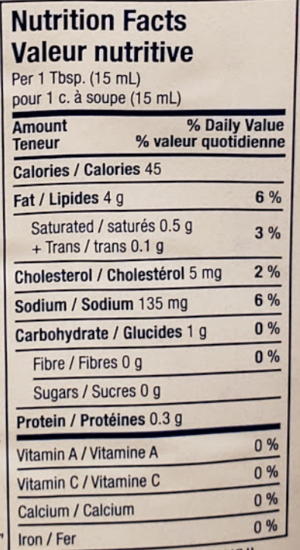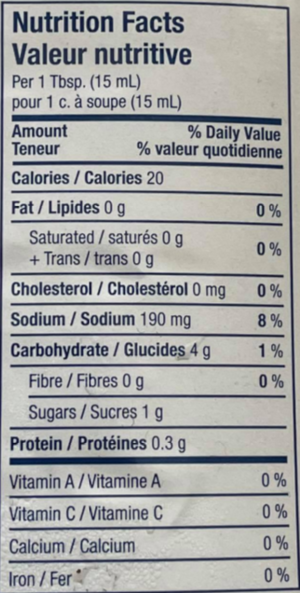Course:FNH200/Assignments/2021/Kraft Caesar Dressing
Introduction
This Kraft Creamy Caesar salad dressing is commonly used to add flavour to our salads. The company, Kraft, is the fifth largest food and beverage company[1] and have produced many different flavours of dressings for different diet needs such as low-fat, fat free and more. Salad dressings can be found in most supermarkets and stores.
Dressing is not only for flavour but also makes the salad more palatable and visually appealing[2]. There are many types of dressings such as oil-based, cream based, mayonnaise- based, and yogurt based[2]. The dressing that will be discussed is mayonnaise based, which is a stable emulsion. The page will discuss the differences between the fat-free version of Kraft Creamy Caesar Salad Dressing and the regular Kraft caesar dressing.
Ingredients:


Kraft Creamy Caesar Salad Dressing: Water, Soybean Oil, Parmesan and Romano Cheese, Corn Syrup, Liquid Egg Yolk, Vinegar, Sugar, Modified Cornstarch, Salt, Garlic, Spices and seasonings, Anchovy Paste, Lactic Acid, Lemon Juice Concentrate, Dried onions, Natural Flavour, Sorbic Acid, Xanthan Gum, Polysorbate 60, Dried Garlic, Calcium Disodium EDTA.
- Fat Substitutes: Modified Cornstarch
- Sugar Substitutes: N/A
- Additives: Lactic Acid, Sorbic Acid, Xanthan Gum, Polysorbate 60
Kraft Fat Free Creamy Caesar Salad Dressing: Water, Corn Syrup, Buttermilk (Milk Ingredients, Salt, Bacterial Culture), Vinegar, Salt, Romano and Parmesan Cheese, Garlic, Natural Flavour, Potato Maltodextrin, Anchovy Paste, Sugar, Modified Corn Starch, Xanthan Gum, Lemon Juice Concentrate, Potassium Sorbate, Colour, Spices and Seasonings (Contains Wheat, Soy), Propylene Glycol Alginate, Dried Sour Cream, (Milk Solids, Citric Acid, Bacterial Culture, BHA, BHT), Phosphoric Acid, Yeast Extract, Calcium Disodium EDTA, Dried Garlic, Silicon Dioxide.
- Fat Substitutes: Potato Maltodextrin, Modified Corn Starch
- Sugar Substitutes: N/A
- Additives: Xanthan Gum, Potassium Sorbate, Propylene Glycol Alginate, Phosphoric Acid, Yeast Extract, Calcium Disodium EDTA
Roles of Fat Substitutes, Sugar Substitutes, and/or Additives used
Fat Substitutes
In both the regular and fat-free versions of this salad dressing, modified cornstarch is used to create a smooth sensation that is similar to products or foods containing more fat. Maltodextrin is used only in the fat-free version to replace fat. It can elicit a fat-like texture by producing a smooth mouthfeel, and because it is bland, it can be used in a variety of applications. This makes it a great option for many fat-free foods with strong flavours, such as this salad dressing.
Sugar Substitutes
N/A
Additives
Many of the additives in both salad dressings are used to contribute certain characteristics to the viscosity and thickness of the dressing, or to suspend certain ingredients to maintain an attractive appearance. Xanthan gum, found in both dressings, is used mainly as a thickening agent and stabilizer, preventing the water and the oil in the dressing from separating. Its thickening properties also help the salad dressing adhere onto salad components, such as lettuce and tomatoes, when served. Propylene glycol alginate in the fat-free version also serves similar thickening purposes as xanthan gum. It mainly acts as a stabilizer, which increases the viscosity of the water in the dressing, allowing the oil droplets to remain suspended. Polysorbate 60, found only in the regular version, is a synthetic emulsifier that also prevents the salad dressing emulsion from separating and aids in the formation of the dressing. As an emulsifier, the molecules of polysorbate 60 have two sides: a hydrophilic side (attracted to water), and a hydrophobic side (repels water). When used in emulsions, the molecule will sit on top of oil droplets in the mixture, with the hydrophilic side facing the water and the hydrophobic side facing the oil; this orientation helps the oil and water stay closely bonded, holding the dressing together. Silicon dioxide, found only in the fat-free version, is largely used in the food industry as an anti-caking agent or as a suspending agent. In the case of salad dressing, it may be used to suspend particles in place, which helps certain food particles stay dispersed throughout the dressing, rather than sinking to the bottom. This creates an attractive looking product for consumers.
Differences between Ingredient Lists of Both Products
Based on the food labels of the regular Caesar dressing and the fat-free option, both products share a majority of the ingredients used. This is to ensure that the consumers will be able to attain a similar taste and texture regardless of which option they choose.
The major selling point of the alternative option is that it is fat-free. Regular salad dressing contains egg yolk and soybean oil, which contain lecithin, a phospholipid that functions as a natural emulsifier. Additionally, Polysorbate 60 is also found in regular salad dressing as a synthetic emulsifier used to prevent oil separation. To avoid the inclusion of fats, the fat-free salad dressing uses potato maltodextrin instead. This carbohydrate-based fat substitute provides the same textural properties as traditional fats at a low-calorie cost. Propylene glycol alginate also serves as a stabilizing agent in the fat-free option. Furthermore, the fat-free alternative contains silicon dioxide. Silicon dioxide is an anti-caking agent that is used to prevent particles from clumping together. Another difference between the two salad dressings is the organic acids they use. Although different types of organic acids were used, they still serve similar functions. In the regular salad dressing, lactic acid is used to enhance tartness, while the fat-free option utilizes phosphoric acid for the same purpose. Moreover, regular salad dressing uses sorbic acid as a preserving agent to maintain the quality of the product. In the fat-free option, this function is performed by potassium sorbate.
| Kraft Creamy Caesar Salad Dressing | Kraft Fat Free Creamy Caesar Salad Dressing |
|---|---|
| Water
Soybean Oil Parmesan and Romano Cheese Corn Syrup Liquid Egg Yolk Vinegar Sugar Modified Cornstarch Salt Garlic Spices and seasonings Anchovy Paste Lactic Acid Lemon Juice Concentrate Dried onions Natural Flavour Sorbic Acid Xanthan Gum Polysorbate 60 Dried Garlic Calcium Disodium EDTA |
Water
Corn Syrup Buttermilk (Milk Ingredients, Salt, Bacterial Culture) Vinegar Salt Romano and Parmesan Cheese Garlic Natural Flavour Potato Maltodextrin Anchovy Paste Sugar Modified Corn Starch Xanthan Gum Lemon Juice Concentrate Potassium Sorbate Colour Spices and Seasonings (Contains Wheat, Soy) Propylene Glycol Alginate Dried Sour Cream (Milk Solids, Citric Acid, Bacterial Culture, BHA, BHT) Phosphoric Acid Yeast Extract Calcium Disodium EDTA Dried Garlic Silicon Dioxide |
(The differences between the 2 ingredient lists are in italics)
Labels
Evaluation of Labels in Accordance with Regulations
According to the regulatory requirements found on the CFIA website, the industry labelling provided by both products (Kraft Creamy Caesar and Kraft Fat Free Creamy Caesar) follow the regulatory requirements for food labelling. Each product clearly displays the common name of the food, being salad dressing, as well as the brand and net quantity all on the front label. Another feature in both products is advertising that the product is made in Canada. Although not mandatory this can be credited to advertising strategy towards a customer by labelling it on the front of the bottle. The expiry date and instructions for the consumer can be found on the sealing at the top of the bottle. In accordance with requirements, both the regular and fat free products have labels written in both official Canadian languages, English and French. Position and location of the bottles is very similar and appropriate while being visible and easy to read. The brand Kraft is well placed and centred on the front and the net quantity can be found at the very bottom of the label, following regulatory guidelines. The ingredient list and nutrition facts can be found on the rear label. The ingredient list also has the “contains” component at the end of the list, clearly and correctly indicating the allergens in each product being milk, anchovy, wheat and soy for the fat free and milk, egg, wheat, soy and anchovy for the regular. The entire rear label follows regulations for sizing, font and displayed information. The Fat Free version is marketed as such with a large banner on the front of the label and 0 fat labels on the back. According to the CFIA website this is permitted as long as there is less than 0.5g of fat on the indicated serving size and this is justified by the nutrition label.
References
Please use the Wikipedia reference style. Provide a citation for every sentence, statement, thought, or bit of data not your own, giving the author, year, AND page.
Note: Before writing your wiki article on the UBC Wiki, it may be helpful to review the tips in Wikipedia: Writing better articles.[3]
- ↑ "Kraft Heinz company".
- ↑ 2.0 2.1 T, Sheevani. "Salad Dressing: Features and Types".
- ↑ En.wikipedia.org. (2018). Writing better articles. [online] Available at: https://en.wikipedia.org/wiki/Wikipedia:Writing_better_articles [Accessed 18 Jan. 2018].
| This Food Science resource was created by Course:FNH200. |


